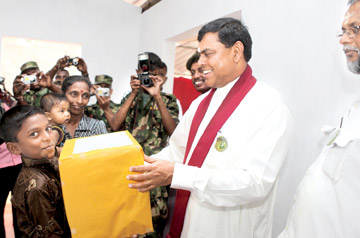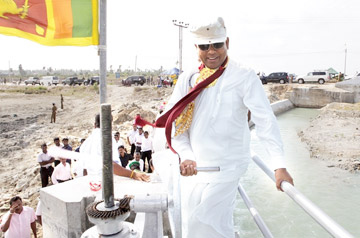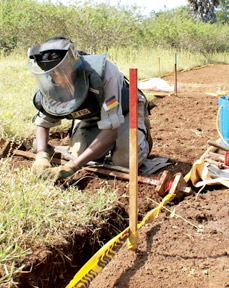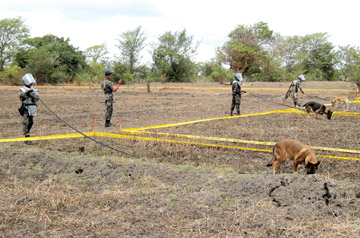Jaffna blooms with Uthuru Wasanthaya program
By Daneshi YATAWARA
Spring is the time where everything starts blooming in vibrant
colours. It is the time when fresh leaves start opening up. It is a
beautiful season that captivates the senses. Spring is what every human
being adores to be his prime! So does 'Northern Spring' or the Wadakkin
Wasantham or Uthuru Wasanthaya. 'Wadakkin Wasantham' is designed to
bring back the spring in the lives of the Northerners of this island
nation.
|

Minister Basil Rajapaksa distributing stationery to school
children |
With the Northern spring, the north rejuvenates. Evidence is seen in
every nook and corner of the province. The start of better times and a
time for high growth, revival and new life! It is fast recovering like
the phoenix that rose from the ashes. Accommodating 5.8% of the entire
Sri Lankan population, the Northern Province is showing an amazing
growth economically as well as socially. Spread across 8,847 square
kilometres the Northern Province, mostly the Jaffna peninsula, is
attracting more travellers than to any part of the country. Its main
economic sectors - i.e. agriculture, fisheries, livestock, industries
and trade - are becoming spectacularly successful.
Northern Spring well known as 'Uthuru Wasanthaya' or 'Wadakkin
Wasantham', was the first well-planned mega development drive the
Government launched, on the directive of President Mahinda Rajapaksa
after the mass exodus of the displaced civilians, following the
liberation of the entire Northern Province by our valiant forces.
Identifying priorities is the key factor in properly implementing such a
mega project.
Northern Spring, operated under the Economic Development Ministry is
a development program catering to the needs of the five districts.
Infrastructure development, electricity, water supply and sanitation,
agriculture, irrigation, livestock development, inland fisheries,
health, solid waste disposal, education, sports, cultural affairs and
transportation are some of the areas that will be included under the
program.
The North also receives the same attention as the South. In fact it
seems to be more! In its efforts to rise from the debris, left over by
devastating terrorism, this is the Government's master plan to rebuild
the Northern Province and restore normalcy in the communities.
|

Opening the Ariyalai salt extrusion bund |
De-mining
Though largely time consuming the de-mining program is in full swing
in the Northern province. "Of the entire Province approximately 443
square kilometers of land is left for mine clearance," said Monty
Ranathunga, Director of The National de-mining Centre under the Economic
Development Ministry. Accordingly majority of the villages and towns are
de-mined and certified as safety areas for human habitation.
"Though de-mining is a more time consuming job we have made
remarkable progress compared to countries like Vietnam, Afghanistan
etc.," said Ranathunga. According to him Sri Lanka is in the forefront
of the few countries who have cleared at least half of its minefields.
Sri Lanka will be able to become a mines free country before 2020 where
as countries like Vietnam says they need 600 years to be cleared from
mine fields.
The National De-mining Centre chief explained resettlement and
agriculture lands are prioritized in the de-mining process. "The
mechanism is on par with international standards is such that when the
first prioritized areas get cleared, the second level becomes high
priority area. This avoids unnecessary delays in the process," he
explained. Following the initial identification of mine fields, a
non-technical survey is done. De-mining includes battle area clearance
and mines field clearance. In Battle area clearance de-miners check the
land surface 10cm deep into the soil. This is in order to remove debris
left over by a battle - i.e. Shrapnel from artillery attacks, used
bullets and pieces, blown up pieces of mortar and many such pieces of
ammunition is removed from the land. "Mine field clearance takes a
longer time. One reason is at risk which is that these mines definitely
will blow up if handled in a wrong method and secondly identifying where
there being buried is a challenge even with the state-of-the -art
technology," Ranathunga explained.
|

A woman de miner clearing a mines field |
Accordingly, about 1,170 square kilometres of land in the North and
the East have been cleared of mines. Nine organisations including the
Army are in the process of clearing the remaining 443 square kilometres.
In Mannar nearly 270 square kilometres of land area have been cleared of
land mines and in the Vavuniya District it is around 167 square
kilometres. In Killinochchi district an area of nearly 568 square
kilometres have been cleared. Ranathunga also said that the railway
track between Medawachchiya to Thalai Mannar and Omanthai to
Kankesanthurai has been cleared of mines and the work on these tracks
can be started soon.
Agriculture
With the commencement of development projects in Jaffna soon after
the end of war the prevention of salt water intrusion into agricultural
lands became the centre stage for livelihood assistance. The Jaffna
mainland and the islands have 34 salt water exclusion bunds out of which
20 have already been reconstructed by the Economic Development Ministry.
The Ariyalai Salt water extrusion bund at Navatkuli in Jaffna, is
constructed at a cost of Rs. 120 million. This prevents salt water
intrusion into the Jaffna lagoon through which water is provided to over
5,000 acres of cultivable land in Jaffna. Economic Development Minister
Basil Rajapaksa during his recent five day tour in Jaffna opened the
Ariyalai bund.
Minister Rajapaksa has advised the ministry officials to set a target
for completion of remaining 14 bunds by end of December 2011. Completion
of all these bunds will help cultivation of 20,000 acres of arable
lands.
The Ministry also with the assistance of the Sri Lanka Army has
cleared 5,560 ha of agriculture lands that were overgrown into forest
patches.
|

Mine detecting dogs in action |
A total of 188 kilometers of tank bunds in the province, "We have
cleared a large area of agriculture lands in the Jaffna district and it
definitely has helped to increase the harvest in the recent months,"
said Nihal Somaweera, Additional Secretary of the Economic Development
Ministry. According to Somaweera a total 1,166 rural roads have been
developed under the 'Maga Neguma' program of the Ministry while the A,B
category roads are developed by the Road Development Authority. "In the
new phase we have started repairing and rebuilding buildings of
Government institutes and already 229 buildings are under
re-construction.
This is happening in all five districts," Somaweera added.
To speed up the on-going development mechanism the Ministry is in the
process of establishing the local authority network , especially in
Killinochchi and Mullaitivu districts.
"Particularly in these two districts the government administration
was annihilated due to LTTE terrorism and now we need to re-establish
it," he added. Accordingly the local authorities who are currently have
established themselves in these districts are rapidly streamlining the
necessary documentation.
Until then the Ministry is directly involved into the development
activities along with assistance from the Office of the Northern
Province Governor. |

